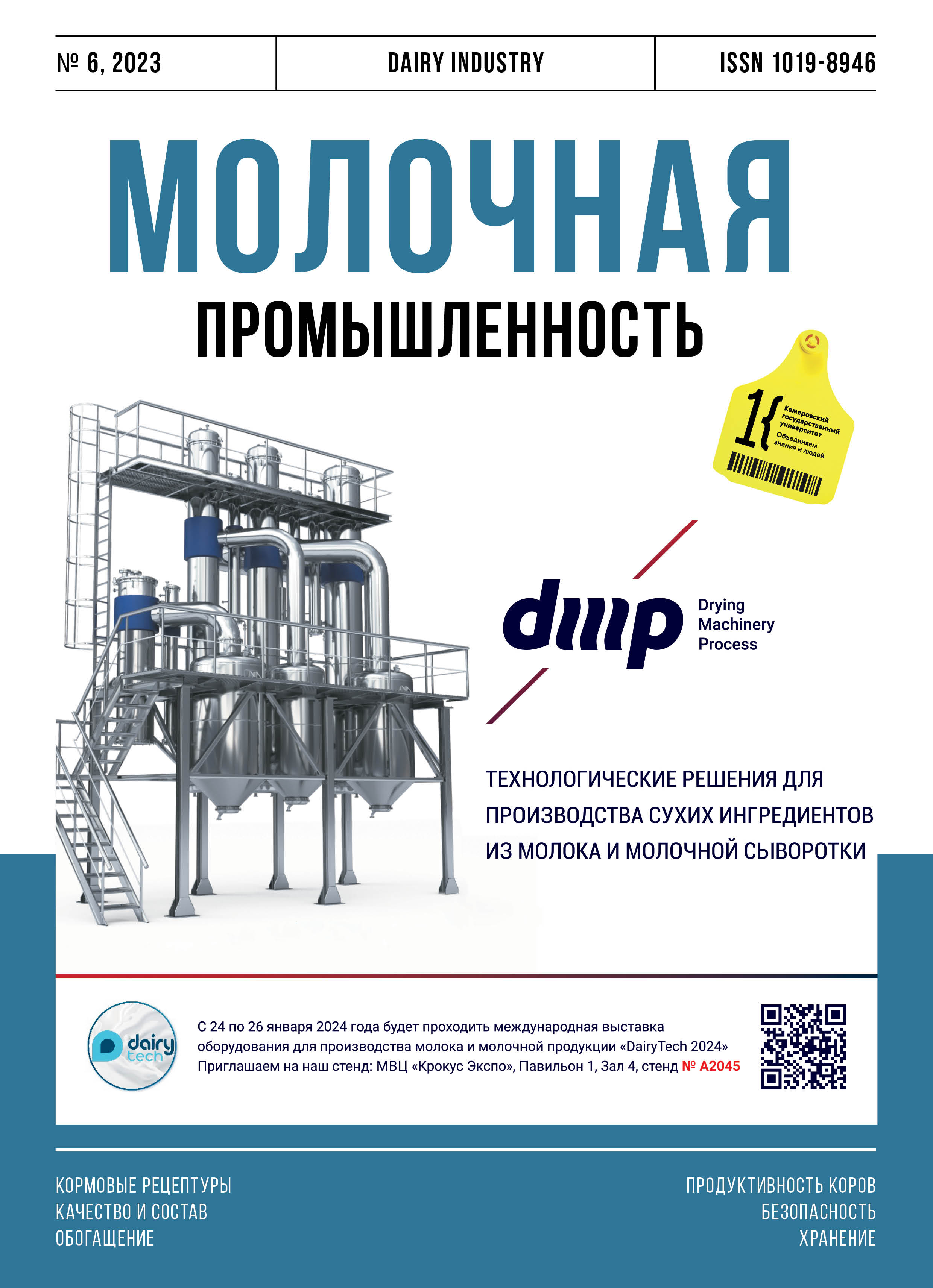Uglich, Russian Federation
Uglich, Russian Federation
Uglich, Russian Federation
Uglich, Russian Federation
The article introduces a comparative analysis of storage capacity of butter packaged in different ways. Butter with a fat fraction of 72.5 % was studied in a monolith sample with stabilized structure and in fluid state during processing. The authors traced the changes in sensory, microbiological, and physicochemical parameters using standard methods at different temperature conditions. When the storage conditions followed State Standard GOST 32261, the in-line packaging method proved more effective: it reduced microbiological risks and increased the shelf-life of the packaged butter. The product also proved resistant to aggravated temperatures, which means that such butter would be able to preserve its quality and safety even under cold chain violations during transportation and sales. The spoilage test results can be used to predict the storage capacity of packaged butter based on initial contamination with various microorganisms.
butter, microbiological indicators, quality, storage capacity, oxidative spoilage
1. Ponomarev, A. N. Bazovyy metod ocenki pokazateley hranimosposobnosti molochnyh produktov / A. N. Ponomarev, Yu. S. Serbulov, K. K. Polyanskiy, L. V. Golubeva // Hranenie i pererabotka sel'hozsyr'ya. 2003. № 7. S. 45–47. https://elibrary.ru/ymbuvl
2. Sidorenko, Yu. I. Prognozirovanie srokov hraneniya prodovol'stvennyh tovarov na osnove eksperimentov, vypolnennyh pri povyshennyh temperaturah (Chast' 1) / Yu. I. Sidorenko, K. B. Gur'eva, S. V. Shterman, S. V. Zverev // Hranenie i pererabotka sel'hozsyr'ya. 2013. №3. S. 27–32. https://elibrary.ru/qzwogl
3. Sidorenko, Yu. I. Prognozirovanie srokov hraneniya prodovol'stvennyh tovarov na osnove eksperimentov, vypolnennyh pri povyshennyh temperaturah (Chast' 2) / Yu. I. Sidorenko, K. B. Gur'eva, S. V. Shterman, S. V. Zverev // Hranenie i pererabotka sel'hozsyr'ya. 2013. № 4. S. 30–33. https://elibrary.ru/qzworz
4. Sviridenko, G. M. Ocenka mikrobiologicheskih riskov v slivkah kak syr'e dlya maslodeliya / G. M. Sviridenko, M. B. Zaharova, N. V. Ivanova // Pischevye sistemy. 2021. № 4(4). S. 259–268. https://doi.org/10.21323/2618-9771-2021-4-4-259-268; https://elibrary.ru/intlsw
5. Topnikova, E. V. Syr'e i rezhimy ego obrabotki kak faktor kachestva i hranimosposobnosti masla / E. V. Topnikova, G. M. Sviridenko, T. P. Kustova // Syrodelie i maslodelie. 2011. № 5. S. 12–16. https://elibrary.ru/ohsgqn
6. Sviridenko, G. M. Vliyanie metodov proizvodstva masla na proyavlenie mikrobiologicheskih riskov, svyazannyh s drozhzhami / G. M. Sviridenko, M. B. Zaharova, N. V. Ivanova // Syrodelie i maslodelie. 2022. № 6. S. 34–37. https://doi.org/10.31515/2073-4018-2022-6-34-37; https://elibrary.ru/hkupcs
7. Sviridenko, G. M. Vliyanie metodov proizvodstva masla na proyavlenie mikrobiologicheskih riskov, svyazannyh s BGKP / G. M. Sviridenko, M. B. Zaharova, N. V. Ivanova, O. I. Smirnova // Syrodelie i maslodelie. 2021. № 4. S. 42–44. https://doi.org/10.31515/2073-4018-2021-4-42-44; https://elibrary.ru/nxbzxr
8. Blekbern, K. de V. Mikrobiologicheskaya porcha pischevyh produktov /K. de V. Blekbern. – SPb: Professiya, 2011. – 784 s.
9. Kashaninejad, M. Effect of extrusion conditions and storage temperature on texture, colour and acidity of butter / M. Kashaninejad, S. Razavi, M. M. Tehrani, M. Kashaninejad // International Journal of Dairy Technology. 2016. Vol. 70. №. 1. R. 102–109. https://doi.org/10.1111/1471-0307.12273
10. Koczon, P. Changes in the acid value of butter during storage at different temperatures as assessed by standard methods or by FT-IR spectroscopy / P. Koczon, E. Gruczynskaan, B. Kowalski // American Journal of Food Technology. 2008. № 3. R. 154–163. https://doi.org/10.3923/ajft.2008.154.163
11. Sukmanov, V. O. Vozdeystvie parametrov processa obrabotki slivochnogo masla vysokim ciklicheskim davleniem na ego ustoychivost' i stabil'nost' kachestva v processe hraneniya / V. A. Sukmanov, I. B. Levit, S. V. Gromov // Vestnik Don NUET: nauch. zhurnal. 2013. Vyp. 57. S. 42–55. (na ukr.)
12. Vyshemirskiy, F. A. Hranimosposobnost' slivochnogo masla russkogo i klassicheskogo metodov proizvodstva / F. A. Vyshemirskiy // Syrodelie i maslodelie. 2017. № 3. S. 43–45. https://elibrary.ru/yujbmd
13. Tverdohleb, A. V. Potochnaya rasfasovka slivochnogo masla i spredov v brikety / A. V. Tverdohleb // Syrodelie i maslodelie. 2016. № 3. C. 54–56. https://elibrary.ru/waokrb
14. Guzmán-Chozas, M. 2-thiobarbituric acid test for lipid oxidation in food: Synthesis and spec troscopic study of 2-thiobarbituric acid-malonaldehyde adduct / M. Guzmán-Chozas, I. M. Vicario-Romero, R. Guillén-Sans //Journalof the American Oil Chemists’ Society. 1998. Vol. 75. № 12. R. 1711–1715. https://doi.org/10.1007/s11746–998–0321–3.





